Iran unveils 'Jihad' missile with enhanced capabilities
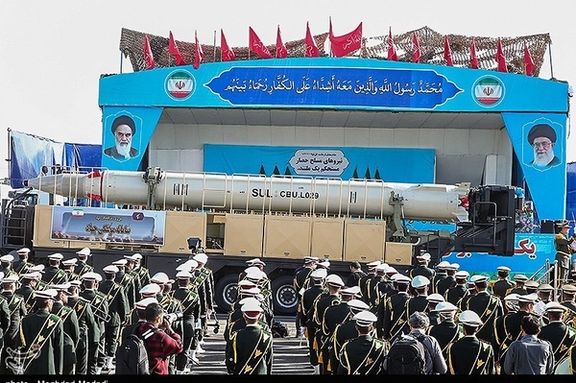
Iran showcased a new ballistic missile named Jihad, developed by the Islamic Revolutionary Guard Corps (IRGC) Aerospace Force, during a military parade in Tehran on Saturday.

Iran showcased a new ballistic missile named Jihad, developed by the Islamic Revolutionary Guard Corps (IRGC) Aerospace Force, during a military parade in Tehran on Saturday.
The Jihad missile system was officially unveiled for the first time on Saturday, introducing a new launch platform for liquid-fueled missiles, according to Iranian government media and IRGC sources.
According to the IRGC-affiliated Tasnim website, it is a ballistic missile with a range of 1,000 kilometers, featuring a dual-missile launcher that distinguishes it from other Iranian liquid-fueled missiles.
Tasnim stated, "A glance at the Jihad missile reveals that it is an optimized version of the Qiam missile, whose range was previously increased from 800 kilometers to 1,000 kilometers, and its warhead became guided."
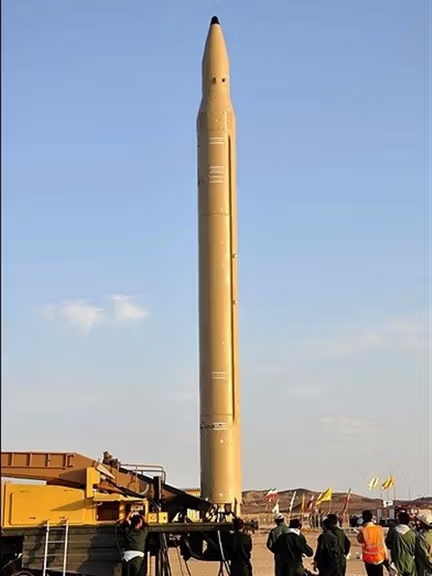
The Qiam missile, Iran's first liquid-fueled missile without fins, was introduced in 2010 with an initial range of 800 kilometers. Its design modification for fin removal allowed for launch from various missile silos. Subsequent enhancements included the replacement of the standard triple-cone warhead with a detachable, guided variant, improving accuracy to within 50 meters, according to Tasnim.
In October 2018, images from an operation revealed the Qiam missile with newly added small fins to enhance its flight profile. By 2021, the Ministry of Defense reported further advancements in the Qiam missile, achieving a range of 1,000 kilometers and marking the emergence of what the IRGC says is a new generation.
According to Tasnim, the Jihad missile is equipped with a warhead weighing approximately 600 kilograms and travels at speeds exceeding eight times the speed of sound. It employs a different launch platform, enabling the simultaneous launch of two missiles, thus enhancing operational efficiency despite the longer preparation time typically associated with liquid-fueled missiles.
Although the Islamic Republic has made continuous advancements in its ballistic missile program, it is not possible to independently verify claims of developing advanced weapons. Around 350 missiles and drones launched against Israel in April, 99% were intercepted by Israeli air defenses and allied warplanes.
Following the introduction of the Kheibar-Shekan and Martyr Haj Qasem missiles, Tasnim reported that a new generation of Iranian ballistic missile launch platforms has also become operational. This platform, used in the Fattah missile, is equipped with the DRU (Precise Navigation System), providing highly accurate positioning data. "This enables rapid firing immediately after deployment, along with swift closure and exit capabilities," the report added.
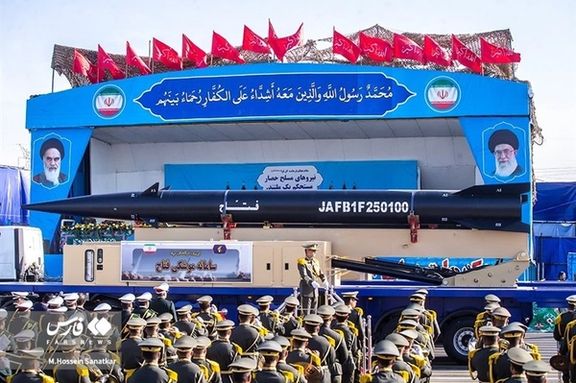
Iran's missile program has generated ongoing concerns among Western nations, particularly the United States and its allies, as Iran invests heavily in developing various ballistic and cruise missiles. The advancements in missile technology have raised alarms about potential threats to regional stability, especially regarding Iran's backing of non-state actors and militant groups.
The potential development of intercontinental ballistic missiles (ICBMs) has prompted calls for tighter controls over Iran's missile program.
In response to the tensions, the United States and its allies have imposed sanctions targeting Iran's missile development, aiming to restrict access to materials and technologies that could enhance missile capabilities.
New sanctions were recently implemented against Iran and its state airline, Iran Air, following allegations of missile deliveries to Russia.
Despite international scrutiny, Iran maintains its right to develop missile capabilities, framing it as a matter of national sovereignty.
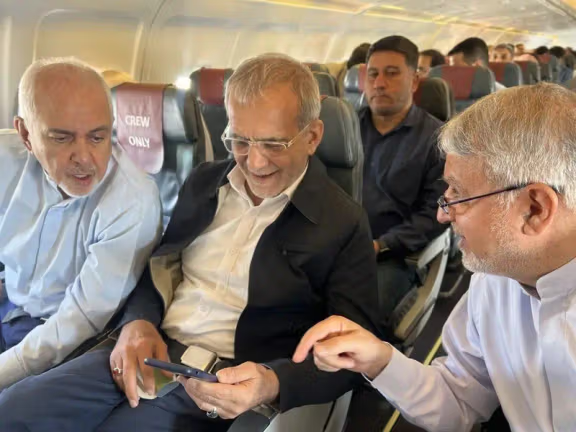
Iran’s President sparked controversy Sunday as he left Tehran for New York's United Nations General Assembly accompanied by a delegation of as many as 40 people, including his adult children.
Among the entourage are Masoud Pezeshkian’s two sons, daughter, and son-in-law.
Reports from outlets such as Modara and Tejarat News in Tehran indicate that in addition to close family members, several individuals linked to Elias Hazrati, the head of the government’s information council, also joined Pezeshkian on the trip.
Pezeshkian had previously faced public backlash after it was revealed that his son-in-law, Hassan Majidi, accompanied him on a government trip to Iraq. It was later revealed that Pezeshkian’s son and daughter had also been part of that delegation.
Iranian media reported last week that Majidi had since been appointed as the executive assistant to the head of the president’s office, raising additional concerns about nepotism within the government.
Modara’s report further highlighted the ongoing secrecy surrounding Pezeshkian's New York delegation, noting: “In Iran, the number of travelers to New York and the president's companions has always been controversial, but no head of state has been willing to transparently disclose the names of their companions on this trip.”
Among the officials confirmed to be traveling with Pezeshkian are Abbas Araghchi, the foreign minister; Mohammad Javad Zarif, deputy for strategic affairs; Zahra Behrouz Azar, deputy for women's affairs; Mehdi Sanaei, political deputy of the president’s office; and Mohammad Jafar Ghaempanah, the executive deputy.
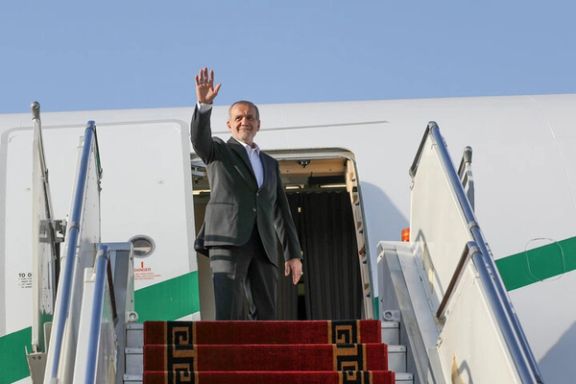
The Trump administration banned Zarif from visiting the United States in 2019, when Washington was pursuing 'maximum pressure' on Tehran.
The presence of government officials' children and family members at state events has long been a point of contention in Iranian politics. On August 28, at the ceremony introducing Mohammad Atabak as the new Minister of Industry, Mine, and Trade, Hamid Reza Aref, the eldest son of First Vice President Mohammad Reza Aref, was seen attending, provoking widespread criticism.
As far back as 2012, during then-President Mahmoud Ahmadinejad’s trip to New York, approximately 140 people accompanied him. Mohammad Ali Pourmokhtar, a member of Iran’s parliament, revealed that many of the travelers were "family members and relatives of government officials."
Iran's latest president, Pezeshkian, stated that his goal for the visit to UNGA is to "neutralize the atmosphere" surrounding the Islamic Republic abroad. Iran has in the last two years been sanctioned for terror activities abroad, support for Russia's war on Ukraine, human rights abuses at home and its ongoing nuclear program.
Speaking on Sunday before his departure, he suggested a desire to win over the Iranian diaspora of whom there are over half a million originally born in Iran. "We can exchange views with Iranians there and neutralize the atmosphere they have created outside the country.
"The reality is not what they present through television, tribunes, or in gatherings," he said. Iran has seen massive activism and protests from its community around the US in a bid to garner international support to overthrow the government, gaining pace since the 2022 uprising.
In a bid to overturn the massively negative perceptions, Pezeshkian said: "Our Iran is much safer and freer than they [foreign media] have depicted."
In an interview with the Entekhab website, Fadahossein Maleki, a member of Iranian parliament's National Security and Foreign Policy Committee, said on Sunday that "the interviews that Pezeshkian will conduct with Western media during his trip to New York will impact the US elections."
Pezeshkian also said that he intends to speak with other heads of state to "create peace and security in the world". It comes one year after the US designated Iran the world's number one state sponsor of terrorism.
Abbas Araghchi, Iran's Foreign Minister, who had already departed for New York ahead of Pezeshkian, said his meetings on the sidelines of the General Assembly on Sunday would center around the conflict in Gaza between Israel and Iran-backed Hamas.
Araghchi said that on the first day, he held "serious discussions" with the foreign ministers of Kuwait and Bahrain, and the Secretary-General of the Gulf Cooperation Council regarding "regional stability and security, the Palestinian issue, Israel's crimes in Gaza and southern Lebanon, the dangers Israeli policies pose to all countries, and the need to counter these policies."
On September 19, Reuters, citing three Iranian officials, reported that Pezeshkian, on his first trip to the West since his election, would carry a message signaling that "Tehran is open to diplomacy", while emphasizing that Tehran will not bow to pressure.
The report predicted that Iranian and European officials at the UN would explore ways to return to diplomacy regarding the Islamic Republic's nuclear program while seeking to reduce tensions with Israel. However, there has been no sign indicating European or US interest in reopening negotiations.
In their initial statements about the trip, neither Araghchi nor Pezeshkian mentioned the nuclear issue in spite of Iran having accelerated its nuclear program and obstructed UN inspectors.
According to the latest confidential reports from the International Atomic Energy Agency, the Islamic Republic continues its high-enrichment uranium production, which could be used for building nuclear weapons.
France, the UK, and Germany, known as the European Troika, have increased pressure on Tehran to return to negotiations.
On September 10, these countries, along with the US, imposed new sanctions on the Islamic Republic due to its supply of ballistic missiles to Russia, an issue which has led to the deterioration of relations between Iran and the West, in addition to Iran's support for its regional proxies.
Since the war in Gaza, Iran's proxies have launched attacks on Israel from countries including Yemen, Syria and Iraq, in addition to Yemen's Houthis imposing a maritime blockade on the Red Sea region which has massively disrupted global shipping.
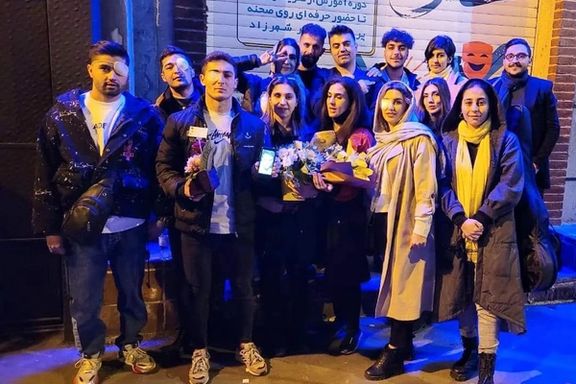
Recent explosions of Hezbollah communication devices in Lebanon and Syria have triggered a complex web of reactions among Iranians, whose government is the primary backer of the armed group.
On September 18 and 19, a suspected Israeli cyber operation caused the explosion of thousands of pagers and hand-held radios used by Hezbollah fighters, resulting in scores of deaths and injuries to more than 3,000 people. Hezbollah immediately blamed Israel and vowed "unique and bloody vengeance" in response. While this event stirred international attention, many Iranians showed a striking lack of compassion toward Hezbollah members. This reaction is deeply rooted in Iran’s internal strife, its government’s ties with Hezbollah, and the brutal repression of dissent in Iran.
Hezbollah, a Tehran-backed militant group based in Lebanon, has long been an extension of the Islamic Republic of Iran's influence in the region. Since its inception in the early 1980s, Hezbollah has received financial, military, and logistical support from the Iranian regime, becoming a key player in Tehran's regional strategy. Many Iranians view Hezbollah as a tool used by the Islamic Republic to pursue its geopolitical interests at the expense of both Iranian citizens and other populations in the Middle East.

Hezbollah's actions have gone beyond mere regional politics. The group has been involved in suppressing dissent in Lebanon, Syria, and even Iran. During the Syrian civil war, Hezbollah fighters actively supported the Assad regime, known for mass atrocities and human rights violations. Furthermore, many Iranians believe that Hezbollah operatives aided in suppressing protests in Iran, particularly during the 2022 "Woman, Life, Freedom" movement. The crackdown on these protests involved violent tactics, including shooting protesters with shotgun birdshots, resulting in numerous injuries and deaths.
The "Woman, Life, Freedom" protests in 2022 were a pivotal moment in Iran, marking widespread dissent against the regime's oppressive policies, especially those targeting women. Iranian security forces used brutal measures to suppress the movement. According to reports, at least 138 individuals lost their eyesight. In addition to this brutal repression, at least 46 children were killed by Iranian security forces during the protests, targeted by birdshots, long-range precision weapons, and baton blows. Many protesters, including these children, were systematically targeted, with security forces aiming for their eyes and faces, leaving deep psychological scars on the Iranian populace.
Considering this history, many Iranians perceive Hezbollah's recent losses not as an isolated tragedy but as part of a broader narrative of retribution against those who have supported or enacted state violence. Social media reactions have been telling in this regard. For example, one commenter sarcastically remarked about the Hezbollah members blinded by the pager explosion, recalling how the regime had blinded numerous protesters in Iran without showing any compassion. The underlying message is that those who have caused pain and suffering are now experiencing a taste of their own medicine.
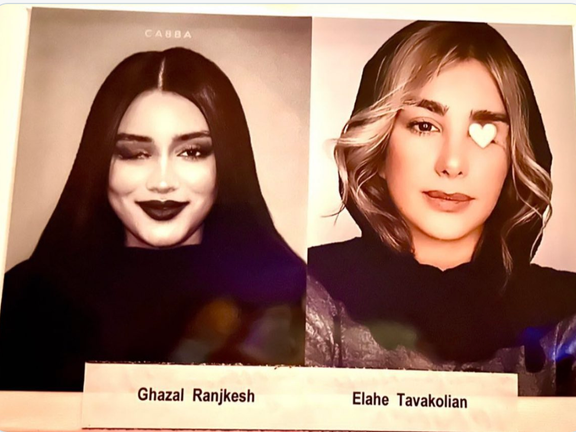
This sentiment is further fueled by the violent tactics historically employed by the Islamic Republic and groups like Hezbollah and Hamas. Suicide bombings, the use of ambulances and civilian planes to transport weapons and militants, kidnappings, and even the use of rape as a weapon of war have been present in the militant Islamist strategy. For decades, these brutal methods have been used to instill fear and maintain control, both within Iran and across the region. Many Iranians now view Hezbollah's current troubles as a form of reckoning—a reflection of the very violence they once helped spread.
There is also a prevailing sentiment among Iranians that sympathy for groups like Hezbollah and Hamas is a "first world luxury." For many in the West, the complex dynamics of the Middle East can often be viewed from a distance, focusing on geopolitical analysis rather than the personal and collective traumas experienced by those directly affected. Many Iranians argue that Western observers sometimes fail to grasp the extent of the suffering caused by these groups, which are not just abstract entities but have actively participated in violence, oppression, and the perpetuation of authoritarian rule.
Iranians also see hypocrisy in Islamists, who wish to impose ancient, draconian laws while simultaneously benefiting from modern technology. These groups preach ideologies that advocate practices from 1,400 years ago, such as polygamy, public flogging, and amputations. Yet, they readily use advanced communication devices, military technology, and even social media to further their cause. Many Iranians argue that those who wish to live by medieval laws and values should not have access to modern technology. This perceived contradiction further fuels the disdain towards groups like Hezbollah, as they are seen as using the advancements of the modern world to perpetuate archaic and violent ideologies.
The difference in reactions between those who have lived through the violence and those who view it from afar is stark. For many in the Iranian diaspora, celebrating the recent attacks on Hezbollah is seen as a celebration of resistance against a network of oppression that has inflicted pain and loss on their communities. They draw a clear distinction between this and the October 7 attack on Israel, which targeted civilians and involved acts of terror against civilians.
The recent pager explosions and the subsequent reactions from Iranians highlight the complexity of violence and justice in the Middle East. While any loss of life is tragic, the reactions among Iranians are shaped by decades of oppression, personal losses, and a struggle for freedom against a political system that they believe leverages groups like Hezbollah to maintain its grip on power.
For many Iranians, Hezbollah's suffering is viewed as poetic justice. It serves as a grim reminder that the tools of violence and repression can turn against those who wield them. The lack of compassion is not from a disregard for human life but from a deep-seated desire for justice and accountability for the countless acts of brutality inflicted upon them.
Opinions expressed by the author are not necessarily the views of Iran International

A deadly explosion at a coal mine in Tabas, eastern Iran, has claimed the lives of at least 50 people, according to government media in Tehran. The death toll could still rise among the injured and missing.
Earlier reports indicated that 24 individuals were still missing. Authorities are bracing for the possibility of more victims as the full scale of the disaster becomes clearer.
However, Entekhab news website in Tehran reported on mid-day Sunday local time that the death toll has risen to 51, with 20 people injured. The increase in fatalities has not yet been officially confirmed.
The accident was caused by a methane gas explosion in two blocks of the mine run by the Madanjoo company, state TV said. There were 69 workers in the blocks at the time of the explosion, it said.
"Seventeen injured people were transported to the hospital and 24 people are still missing," state TV earlier said citing the head of Iran's Red Crescent.
On Sunday morning, Javad Ghana'at, the governor of South Khorasan Province, confirmed that the death toll from the coal mine explosion had risen to 30, with 17 others injured. The explosion, which occurred at around 9 p.m. on Saturday, was initially reported by Iranian media to have claimed one life, with rescue teams unable to reach other trapped workers. The blast impacted two sections of the mine, where 22 workers were in Block B and 47 in Block C at the time of the incident.
Experts speaking to Iran International television explained that equipment in Iranian mines are sometimes defective, old or unsuitable to deal with potential dangers. Oxygen tanks are often not filled completely and devices to measure dangerous gases sometimes do not function.
The ministers of industry, and labor have been dispatched to Tabas by order of President Masoud Pezeshkian to follow up on the matter.
Local media report that Pezeshkian also emphasized that the cause of this incident should be “thoroughly investigated and announced, and any potential culprits should be dealt with firmly.”
The head of the judiciary, Gholamhossein Mohseni Ejei also said that “all aspects of the incident be quickly investigated and appropriate legal action be taken against any potential offenders.”
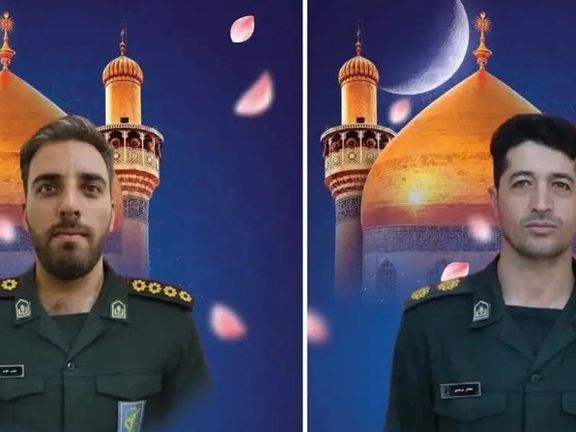
In a Wednesday broadcast, an Iranian Internet TV channel revealed that Israeli operatives pulled off a clandestine mission in Iran over the past month, leading to casualties and the theft of sensitive documents.
Vahid Khazab, a host on the internet TV channel "Asr," remained tight-lipped about the specifics of the operation, revealing only that a well-connected friend within the security services had informed him about the attack.
Curiously, the Wednesday episode—which covered the latest developments involving Israel and Palestine—has since become inaccessible.
After the program aired, attention quickly shifted to an incident, which could fit the criteria: a reported gas leak on August 29 at an IRGC facility in Isfahan, resulting in the deaths of two senior officers, Captain Mojtaba Nazari, and Lieutenant Colonel Mukhtar Morshidi, and injuring 10 others. In its official statement at the time, the IRGC kept details deliberately vague, omitting the name of the facility and its operations. The statement attributed the incident to a "gas leak" but did not clarify whether the officers died from gas asphyxiation or an explosion.
The host of the "Meydan" program left things ambiguous, not specifying whether he was referring to this particular incident or an undisclosed operation that neither Iranian officials nor the media have acknowledged so far.
Criticizing the strategy of concealing operations on Iranian soil, the other host of the program, Ruhollah Razavi, pointedly remarked: "It seems there's no intention to mention that Iranians, same as the Lebanese, have also been martyred."
Khazab, nodding in agreement, remarked, "Hasn’t Israel conducted operations this past month? Has anyone said a word? Haven’t these operations resulted in martyrs?" His statement trailed off as he deliberately avoided mentioning specific names. He then sharply criticized the silence from officials and relevant agencies, saying, "It seems the strategy is to remain silent so that no one truly knows what’s happening."
The hosts hinted that officials might believe keeping things under wraps avoids public scrutiny—after all, with no visible retaliation and security looking a bit shaky, it might not paint the best picture.
"It's a strategy that if these things are brought up, expectations rise. For example, an ordinary person might say, 'Oh come on, they just talk and do nothing!'" Khazab added.
This scenario has already unfolded, with Tehran issuing multiple declarations of retribution for the killing of Ismail Haniyeh in July in Tehran, yet no retaliatory actions have materialized. The lack of any visible response has led some to question whether the promises were ever meant to be fulfilled, ultimately undermining the image Tehran seeks to project as a strong and dominant power in the region.
Later on Saturday, IRGC-affiliated Tasnim News refuted the statements made in the program, quoting an unnamed security official who stated, “All the facts in this report are incorrect, and it is unclear which uninformed source provided such information to them.”
The "Asr" Internet TV website provides no information about its ownership, yet the channel's content closely aligns with the IRGC's narrative. However, in 2014, Ramezan Sharif, then head of IRGC public relations, denied claims that the IRGC had launched a private radio-television network under the name "Asr."
Sharif said in his statement: "The IRGC has never intended to create a private radio-television network. The 'Asr' network is part of the Islamic Republic of Iran Broadcasting (IRIB), designed as part of the national media's broader effort to meet audience needs."

A group of Iranian Americans have launched ‘Iranians for Trump’, a movement to mobilize support for presidential candidate Donald Trump in the upcoming US elections.
Sarah Raviani, the spokesperson for the group’s English division, is the opposite of what a stereotypical traditional Trump supporter, often portrayed in mainstream media, would be.
She’s young, from generation Z, educated, and comes from an immigrant background. Her family fleeing shortly after the clerical establishment, once led by Ruhollah Khomeini, ousted the monarchy and created the Islamic Republic of Iran in 1979.

“We think that President Trump is the best option for our community to support the policies that we want and we need for freedom and democracy in Iran and for protecting and safeguarding American national security,” said Raviani.
The issue of national security and policies implemented during the first Trump administration on Iran such as pulling out of the JCPOA nuclear deal, the listing of the IRGC as a terrorist entity and the assassination of Gen. Qassem Soleimani, proved to Raviani that the former President was tough on the Iranian regime.
National security and international relations analyst Shayan Sami’i said the Biden-Harris administration's policies towards Iran have tilted some Iranian Americans towards Trump.
“Disillusionment with the Democrats, a perception of strength by Trump, and the perception of an “appeasement” approach toward the Islamic Republic by the Biden Administration makes Iranian Americans gravitate toward Trump.”
The Biden administration issued a waiver in 2023 for international banks to transfer $6 billion in frozen Iranian money from South Korea to Qatar, in exchange for the release of five American citizens detained in Iran. As part of the deal, the administration also agreed to release five Iranian citizens in the United States. Republicans point to the fact that the Oct. 7 attack on Israel, launched by Iran-backed Hamas, happened shortly after the release of these funds.
The mentality of the Iranian American voter is also influenced by the history of the Islamic Revolution.
The Islamic Revolution happened under during the Jimmy Carter's Democratic administration, meaning Iranians historically have been weary of the Democrats, said Sami’i.
“The 1979 Islamic Revolution occurred during a Democratic party administration and Democratic administrations were harsher on Iran’s monarchy, making Republicans appear as their true friends. However, Republican presidents, just like their Democratic counterparts, have provided nothing more than lip service and back-pedaling. They have stated good and heart-warming words but no concrete action.”
The “tough” guy image of Trump is often seen as big win for the Iranian Americans whose way of thinking is valuing toughness. This especially applies to those who fled at the start of the revolution, having great fear of the Islamic Republic, Sami’i told Iran International.
Nicole Namdar, a 35-year-old business advisor from Great Neck, NY, now living in Florida, is Iranian Jewish and she’s voting for Trump.
She’s a liberal when it comes to social issues, but she often feels the Democrats respond ‘too little, too late’ and are ‘blind to the realities’ of the threat of the Islamic Republic. Namdar said as a Jewish person, who lost her homeland of Iran to the revolution, she said she needs to feel safe in the land her family came to seek refuge.
“I don’t want to live through an Islamic revolution that my family lost their country to,” said Namdar.
The Foundation for Defense of Democracies' Behnam Ben Taleblu, said while no group is a monolith, the social impact of Trump’s Iran policy has earned him support from a wide verity of Iranian Americans.
“The breaking of taboos to include vocally and vociferously supporting the Iranian people in every iteration of their protests against the regime, killing Iran’s chief terrorist Qassem Soleimani, and unilaterally reimposing sanctions on the regime to rob it of revenues has earned the former president deep support from broad swaths of the Iranian American community,” said Taleblu.
While political engagement and participation is key in any election, Iranian Americans are not going to have significant impact on the outcome of the election, according to Arash Ghafouri , the CEO of Statis Consulting.
In the previous election, according to a poll by Zogby Research Services, 87 percent of Iranian Americans were registered to vote in the US. Of that number, 52 percent are Democrats and 8 percent are Republicans. But 40 percent identify themselves as either independent or have no party affiliation.
Raviani believes that has shifted significantly in the past 4 years and gave her own personal experience of an Iranian American activist who went from being a staunch Democrat, a never Trump voter, to now being one of his biggest supporters.
“I see a lot of the community has shifted into becoming single issue voters, and this happened as a result of the uprising in 2022 in Iran. And like I said, a lot of Iranian Americans identified as either apolitical Democratic voters or independents.”
Click on YouTube Iran Internationa's Podcast playlist to watch the full episode of this week's special edition of Eye for Iran from Washington DC.